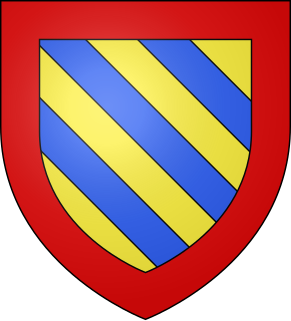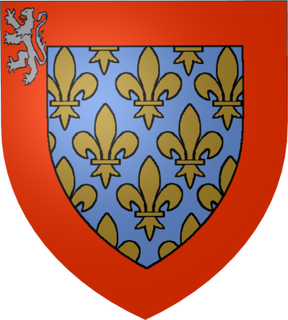Otto-William was count of Mâcon, Nevers, and Burgundy.
The County of Boulogne was a county within the Kingdom of France during the 9th to 15th centuries, centred on the city of Boulogne-sur-Mer. It was ruled by the counts of Flanders in the 10th century, but a separate House of Boulogne emerged during the 11th century. It was annexed by Philip II of France in 1212, after which it was treated as part of the county of Artois until it was finally annexed into the royal domain in 1550.
Fulk I of Anjou — Foulques le Roux — held the county of Anjou first as Viscount, then Count, until his death.
Fulk II of Anjou, called le Bon was Count of Anjou from 942 to his death.

Geoffrey I of Anjou, known as Grisegonelle, was count of Anjou from 960 to 987.

William III of Ponthieu also called William Talvas. He was seigneur de Montgomery in Normandy and Count of Ponthieu.
Conan I nicknamed Le Tort was the Duke of Brittany from 990 to his death.
Ermengarde of Anjou, known as Blanche, was a Duchess consort of Burgundy. She was the daughter of Count Fulk III of Anjou and Hildegarde of Sundgau. She was sometimes known as Ermengarde-Blanche.
Odo II was the count of Blois, Chartres, Châteaudun, Beauvais and Tours from 1004 and count of Troyes and Meaux from 1022. He twice tried to make himself a king: first in Italy after 1024 and then in Burgundy after 1032.
La Tour d'Auvergne was a noble French dynasty. Its senior branch, extinct in 1501, held two of the last large fiefs acquired by the French crown, the counties of Auvergne and Boulogne, for about half a century. Its cadet branch, extinct in 1802, ruled the duchy of Bouillon in the Southern Netherlands from 1594, and held the dukedoms of Albret and Château-Thierry in the peerage of France since 1660. The name was also borne by Philippe d'Auvergne, an alleged collateral of the original Counts of Auvergne, and was adopted by the famous soldier Théophile Corret de la Tour d'Auvergne, who descended from an illegitimate line of the family.

The House of Baux is a French noble family from the south of France. It was one of the richest and most powerful families of Medieval Provence, known as the 'Race d’Aiglon'. They were independent Lords as castellan of Les Baux and Arles and wielded very considerable authority at local level. They held important fiefs and vast lands, including the principality of Orange.
William I, called the Liberator, was Count of Provence from 968 to his abdication. In 975 or 979, he took the title of marchio or margrave. He is often considered the founder of the county of Provence. He and his elder brother Rotbold I were sons of Boson II of Arles and his wife Constance, who, based on her name, has been speculated to be daughter of Charles Constantine of Vienne. They both carried the title of comes or count concurrently, but it is unknown if they were joint-counts of the whole of Provence or if the region was divided. His brother never bore any other title than count so long as William lived, so the latter seems to have attained a certain supremacy.

William II, called the Pious, was the Count of Provence.
Rotbold I was a French nobleman. He was Count of Provence from 968 until his death and margrave from 993. He was the elder of two sons of Boso II of Provence and Constance of Vienne, his younger brother being William I, who took up the title of marchio in 979 and that of dux later. He ruled with William, probably jointly over the whole county. On William's death, Rotbold was left as head of the family with the title of marchio.

Adelaide-Blanche of Anjou was, by her successive marriages, countess of Gévaudan and Forez, of Toulouse, of Provence, and of Burgundy, and queen of Aquitaine. She was the regent of Gevaudan during the minority of her sons in the 960s, and the regent of Provence during the minority of her stepson from 994 until 999.
Rotbold II was the Count and Margrave of Provence from 1008 to his death. He was the only son of Rotbold I and Emilde, daughter of Stephen, Viscount of Gévaudan. He inherited all his father's titles on his death in 1008. He is an obscure person, difficult to differentiate from his father.
Hugh was the Count of Rouergue and Gévaudan from 1008 to his death. He was the son and successor of Raymond II and he inherited suzerainty over neighbouring counties and over Narbonne.

Hugh IV was Count of Maine from 1036 to 1051.
Ermengarde of Anjou,, was the Countess of Rennes, Regent of Brittany (992–994) and also Countess of Angoulême.
Marie I of Auvergne was suo jureCountess of Auvergne and Countess of Boulogne from 1424 to her death in 1437, having inherited the titles from her cousin Joan II, Countess of Auvergne. She was also styled Dame of Montgascon. She was the wife of Bertrand IV de La Tour, and the mother of Bertrand V de La Tour who succeeded her as Count of Auvergne and Boulogne.





